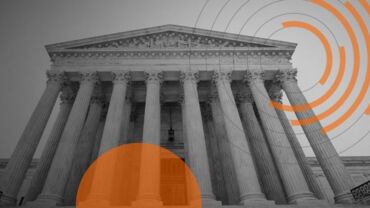Some legal professionals may have hesitancy around generative AI, but the tools are already at work, transforming court operations while expanding access to justice
As generative artificial intelligence (GenAI) becomes more common, judges are discussing its potential role in courts. While government and legal profession respondents recognize opportunities for cost savings and reduction with GenAI, concerns about reliability and accuracy hinder its application, according to findings in the 2024 Generative AI in Professional Services report from the Thomson Reuters Institute.
Despite these concerns, however, there are opportunities to use GenAI to enhance customer experience and increase access to justice in civil courts across the United States.
GenAI in docket management
Judge Scott Schlegel of the State of Louisiana’s Fifth Circuit Court of Appeal advocates for GenAI’s potential to modernize court docket management and enhance customer experience. And there is clearly a need for this type of modernization — 17% of hearings in 2023 were delayed more than 15 minutes, with failure-to-appear, both in-person and virtually, as a major cause, according to the 2024 State of the Courts Report from the Thomson Reuters Institute.
Further, the Superior Court of California has introduced a court reservation system in Los Angeles County which allows litigants to make and manage their own reservations on the docket, within parameters established by courtroom professionals. This allows for courts to manage their docket days and workloads but offers litigants a level of flexibility in their scheduling. One additional feature is the ability for litigants to subscribe to a hearing reminder service to schedule email and text message reminders about their hearings.
Research from the University of Virginia shows that smarter court scheduling technology like these examples can increase equity, efficiency, and reduce failure-to-appear rates.
While these innovations could make docket management easier for many citizens, half to three-quarters of middle- and low-income Americans still struggle with access to legal guidance and representation for civil matters such as eviction, bankruptcy, workplace injuries, debt litigation, and more.
A Fordham Urban Law Journal study found that Legal Service Corporation-funded organizations simply can’t keep pace with demands — providing inadequate or no help for 71% for civil cases.
Fortunately, GenAI can further aide pro se (self-represented) litigants in high-frequency, low-complexity civil matters. A stakeholder session facilitated by Stanford University’s Justice Innovation Legal Design Lab highlighted current and potential uses of GenAI in court matters that do not constitute unauthorized practice of law, which would prohibit their use in some cases. These applications include drafting legal help guides, preparing court forms, and checking documents for errors in user’s preferred language.
Concerns and solutions
Critics have voiced concerns about GenAI tools related to a potential lack of empathy, the reinforcement of systemic historical biases, or oversimplification of complex legal information. Also, the increasing presence of GenAI tools will require users to have regular access to high-speed internet service, which is not universally accessible for all citizens. This digital divide, or the gap between those with or without access to high-speed internet, disproportionately impacts lower-income and rural households.
One important consideration for organizations to remember is that 15% of Americans are Smartphone-only internet users, and the future deployment of mobile-friendly GenAI applications will ensure that these tools reach a larger audience, especially those individuals who face barriers to high-speed internet.
And more tools and customer service innovations are coming on-line every day, potentially alleviating access-to-justice concerns. For example, the Clerk of the Superior Court of Maricopa County, Arizona offered a strong example of GenAI’s potential by introducing Cleo, a virtual office assistant and interactive chatbot. The tool now handles 86.5% of customer conversations, which has saved the County more than $28,000 in the second quarter of 2022 (the last quarter for which data was available.) An average of nearly 10,500 users per month accessed Cleo through text-based interactions, earning the County a customer satisfaction score of 90.7 out of 100.
Similarly, the Eleventh Judicial Circuit of Florida uses their own avatar named SANDI — an acronym for Self-Help Assistant Navigator for Digital Interactions. SANDI, which uses an action knowledge base of more than 900 questions, offers individuals the ability to talk via microphone in a speech-to-text fashion rather than typing. An average of 950 pro se litigants use the tool each month, which has reduced the need for human-driven chats by 94%. The tool offers bilingual conversational assistance in English and Spanish, and there are plans in the works to add Creole as a third language.
Considerations in future GenAI applications
Courts across the US face redundancy in developing GenAI tools due to jurisdictional differences; however, there are excellent examples from public and private sector legal professionals that can be modeled.
LegalYou, a tool developed by Ice Legal, a consumer protection firm with offices in Florida and New Hampshire, has created short videos and visual media (including infographics and quizzes) that break down legal complexities into “bite-sized, easy to understand snippets.”
The Northwest Justice Project (the largest publicly funded legal aid program in Washington State) maintains the Washington Law Help website, with an extensive library of legal resources, DIY court forms, and language provisions for more than a dozen languages, as well as videos for those who are hearing or sight impaired.
Early examples like Cleo and SANDI demonstrate the twin successes of improving user experiences while saving taxpayer money. While it may be a time-intensive undertaking for any individual court system to develop their own tools, data supports the fact that GenAI legal resources can expand access to justice and reduce employee workload in a court setting, providing benefits to all involved parties.
You can find more articles about Access to Justice here.







